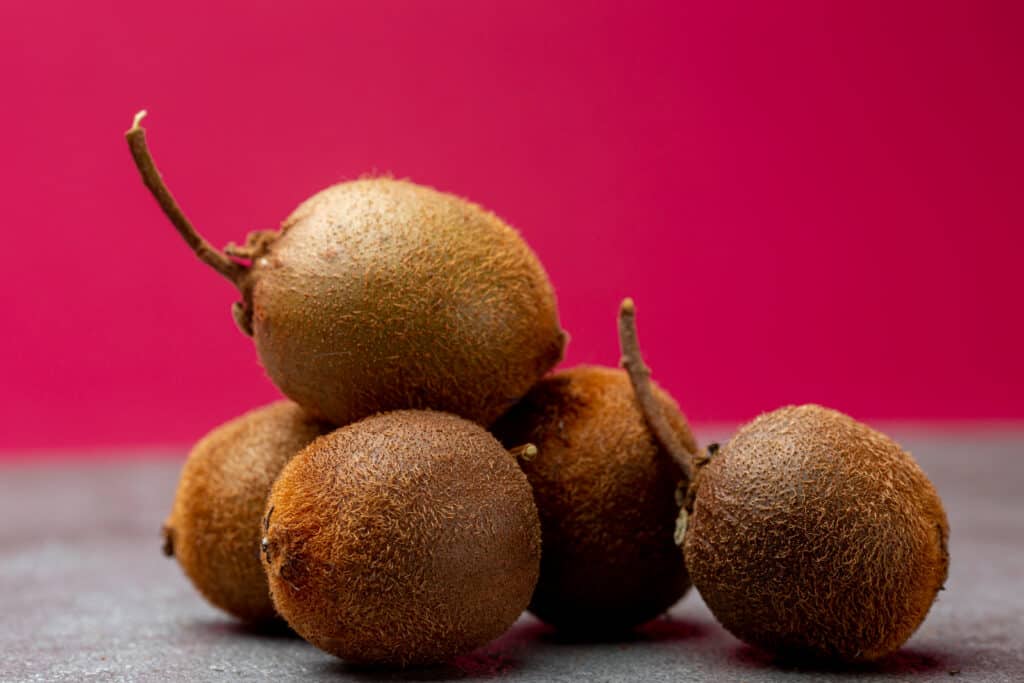Catnip is a plant that is well known for the euphoric response that it triggers in cats. But did you know there is a lesser-known plant that does exactly the same thing? That’s right; the silver vine is also a feline-friendly plant. But what are the differences between them, and which is best for your furry friend? Let’s discover everything you need to know about silver vine vs. catnip!
Comparing Catnip vs. Silver Vine

Catnip
(Nepeta cataria)is a plant in the
Nepetagenus within the
Lamiaceaefamily group, commonly known as the mint or sage family.
©Anna Gratys/Shutterstock.com
| Catnip | Silver vine | |
|---|---|---|
| Classification | Nepeta cataria | Actinidia polygama |
| Alternative Names | Catwort, catmint | Cat powder, matatabi |
| Origin | Asia, China, Middle East, southern and eastern Europe | China, Japan, Korea |
| Habitat | Woodlands, meadows, pastures, roadsides, wasteland | Mountainous regions at elevations between 1,600 and 6,200 feet |
| Size | 2 to 3 feet | Height – 12 to 20 feet Width – 8 to 10 feet |
| Leaves | 3 inches, green, heart-shapes, serrated edges, covered with white hairs | 2.5 to 5.1 inches, heart-shaped, green with silver-white markings |
| Flowers | White, often with purple spots | White |
| Fruit | Small pod filled with seeds | 1.2 to 1.6 inches long, orange, resembles kiwifruit |
| Active Compound | Nepetalactol | Nepetalactol, actinidine, and dihydroactinidiolide |
The 7 Key Differences Between Silver Vine and Catnip
The main differences between silver vine and catnip are the plants’ size, their leaves’ appearance, and the fruit they produce. Silver vine is much taller than catnip and has distinctive green and white leaves. It also produces fruit, whereas catnip does not. The other differences between these two plants include their active substances and how cats react to them.
Silver vine vs. Catnip: Classification

Silver vine
(Actinidia polygama)is a plant in the
Actinidiagenus within the
Actinidiaceaefamily group.
©olenaa/Shutterstock.com
The first difference between these two plants is how they are classified. Despite their similarities, they are not actually related. Silver vine (Actinidia polygama) is a plant in the Actinidia genus within the Actinidiaceae family group. There are approximately 360 species within Actinidiaceae, and they are all typically either vines or small trees and shrubs.
Catnip (Nepeta cataria) is a plant in the Nepeta genus within the Lamiaceae family group, commonly known as the mint or sage family. Most of the plants in the family are known for being highly aromatic. There are approximately 250 species within Nepeta, and several of them – including catnip – are renowned for their effect on cats.
Silver vine vs. Catnip: Origin & Habitat
Catnip is a plant that grows in various temperate habitats – including woodlands, meadows, pastures, wasteland, and even along roadsides. It is native to Asia, China, the Middle East, and southern and eastern Europe. However, it has also become naturalized in northern Europe, North America, and New Zealand.
Silver vine is native to China, Japan, and Korea, where it naturally occurs in mountainous regions at elevations between 1,600 and 6,200 feet.
Silver vine vs. Catnip: Size

Catnip typically grows to 2 to 3 feet tall in its natural habitat and up to the same width.
©iStock.com/guppys
A very distinct difference between silver vine and catnip is their size, as silver vine is much larger than catnip. Catnip typically grows to 2 to 3 feet tall in its natural habitat and up to the same width.
However, the silver vine can grow to anything between 12 and 20 feet tall with a width of between 8 and 10 feet. Silver vine is a deciduous climbing plant that scrambles higher and higher, twining its branches around as it goes.
Silver vine vs. Catnip: Leaves
When we look at the foliage of silver vine and catnip, it is easy to see the difference between their leaves. Catnip has heart-shaped leaves with strongly serrated edges. They are approximately 3 inches long, green, covered with fine white hairs, and smell strongly of mint.
However, the silver vine gets its name from its leaves which have a very distinct appearance. Although they are also heart-shaped, they are usually larger than catnip- approximately 2.5 to 5.1 inches long and 1.5 to 3.5 inches wide. They are green with unique silver-white markings, giving them a striking appearance.
Silver vine vs. Catnip: Flowers

Silver vine contains many active substances, but the main ones that cats react to are nepetalactol, actinidine, and dihydroactinidiolide.
©masa.t/Shutterstock.com
Catnip and silver vine produces small flowers, although they appear slightly differently. Silver vine develops clusters of small, cup-shaped white flowers, which often have yellow centers. These bloom from early to mid-summer every year.
Catnip develops long spikes which are adorned with white flowers. These white flowers often have small purple spots, giving them a distinctive appearance.
Silver vine vs. Catnip: Fruit

The silver vine produces small fruit of around 1.2 to 1.6 inches long and 1 inch wide.
©Maarten Zeehandelaar/Shutterstock.com
Easily one of the main differences between silver vine and catnip is that silver vine produces fruit while catnip doesn’t. The silver vine produces small fruit of around 1.2 to 1.6 inches long and 1 inch wide. They bear a strong resemblance to kiwifruit – although they are orange rather than green. However, silver vine develops separate male and female plants, and the fruit only grows on the females. The fruit can either be eaten raw or cooked.
In comparison, catnip doesn’t grow any fruit as such. Instead, they develop small pods which are filled with approximately four small, reddish-brown seeds.
Silver vine vs. Catnip: Active Compounds & Effect on Pets

Upon detecting catnip, most cats react by rubbing themselves over the plant, rolling on the ground, and licking and chewing it.
©iStock.com/Sergey Spritnyuk
Although catnip is the better known of the two plants for its effect on cats, silver vine actually affects our feline friends too. These plants have such an effect on them because they contain active compounds- usually in the form of essential oils – which the cats react to. However, silver vine and catnip contain different compounds. Catnip produces nepetalactol which they detect through their olfactory epithelium, where it then binds to their olfactory receptors. Upon detecting catnip, most cats react by rubbing themselves over the plant, rolling on the ground, and licking and chewing it. In some cases, they can become hyperactive or even aggressive – although the effects will wear off after a short while. However, if they eat it, then it can act as a sedative and make them sleepy.
Silver vine contains many active substances, but the main ones that cats react to are nepetalactol, actinidine, and dihydroactinidiolide. These are typically more potent than the nepetalactol, which is in catnip. This means that silver vine generates a more intense response from cats – think catnip but much stronger. Occasionally, some cats don’t respond to catnip – researchers put this figure at around 50 % – but studies suggest that most will usually respond to silver vine.
Up Next
- Is Catnip Safe For Dogs To Eat? What Are The Dangers?
- The Science Behind Catnip – What It Does To Cats
- Toxic Plants For Cats
The photo featured at the top of this post is ©
Sources
- Gardenia, Available here: https://www.gardenia.net/plant/nepeta-cataria
- Gardenia, Available here: https://www.gardenia.net/plant/actinidia-polygama
- Washington State University, Available here: http://www.pnwplants.wsu.edu/PlantDisplay.aspx?PlantID=521
- Wikipedia, Available here: https://en.wikipedia.org/wiki/Catnip
- Wikipedia, Available here: https://en.wikipedia.org/wiki/Actinidia_polygama
- PetMD, Available here: https://www.petmd.com/cat/general-health/silver-vine-plant-alternative-catnip
- Natural Cat Toy, Available here: https://www.naturaltoys4cat.com/silvervine-and-the-catnip-plant-whats-the-difference/
FAQs (Frequently Asked Questions)
Why is it a good idea to give catnip or silvervine to cats?
Apart from the euphoric pleasure than cats experience when exposed to these two plants, it can encourage your kitty to play. This is useful if your cat is overweight as exercise is a great way for them to fight obesity. Also, by encouraging your cat to play it can help them to relive any stress or anxiety that they might be feeling and it’s a great way for you to bond with your cat. Additionally, some researchers believe that it can even help to alleviate minor pain.
Are any parts of catnip and silvervine poisonous?
No, there are no parts of either plant that have shown to have any kind of toxic effect on either humans or animals. Although, if your pet eats a lot of either plant then there is always the possibility of it causing an upset stomach.
Are there any other uses for catnip and silvervine?
As well as attracting cats, catnip is great for attracting butterflies – so if you want any in your garden then planting catnip is a good way to achieve it. Also, the nepetalactone in catnip can work as a mosquito repellent. Additionally, both plants are widely used in traditional medicine to treat minor ailments.
Are catnip and silvervine easy to grow?
Yes, both plants are easy to grow. Silvervine grows well in well-drained soil so long as it has access to either full or part sun. As it is a vine it is great for planting near a wall or trellis to that it has something to climb up.
Catnip is particularly drought-resistant and can cope with fairly dry soil while in full sun or part shade. It is low maintenance and is suitable for flower beds and borders.
Thank you for reading! Have some feedback for us? Contact the AZ Animals editorial team.






